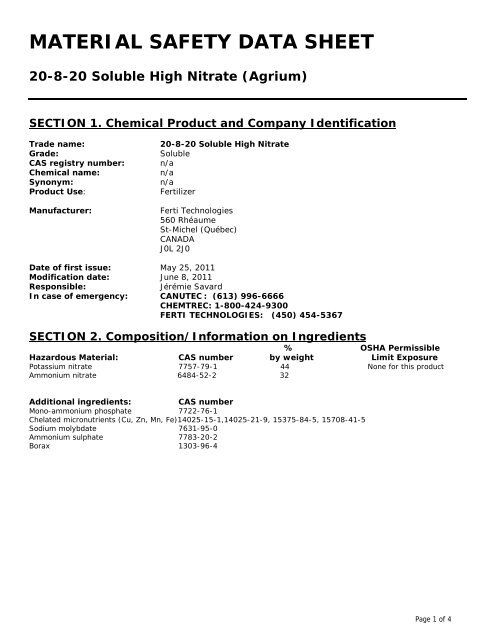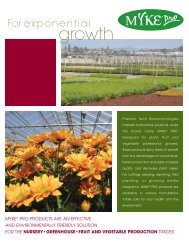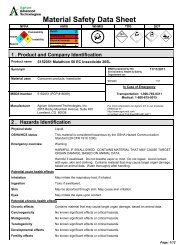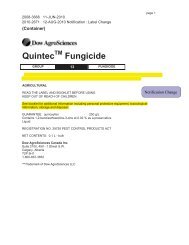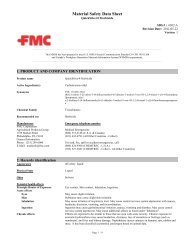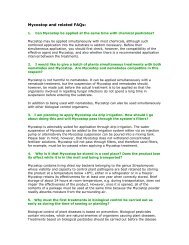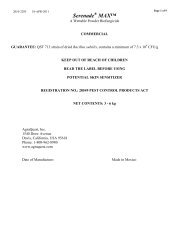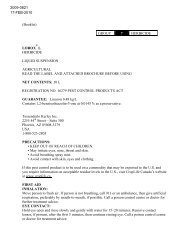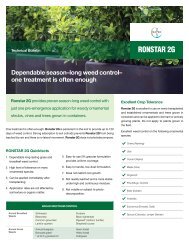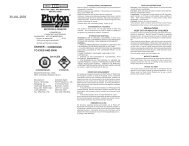20-8-20 High Nitrate soluble Agrium EN MSDS ANSI
20-8-20 High Nitrate soluble Agrium EN MSDS ANSI
20-8-20 High Nitrate soluble Agrium EN MSDS ANSI
You also want an ePaper? Increase the reach of your titles
YUMPU automatically turns print PDFs into web optimized ePapers that Google loves.
MATERIAL SAFETY DATA SHEET<br />
<strong>20</strong>-8-<strong>20</strong> Soluble <strong>High</strong> <strong>Nitrate</strong> (<strong>Agrium</strong>)<br />
SECTION 1. Chemical Product and Company Identification<br />
Trade name:<br />
Grade:<br />
CAS registry number:<br />
Chemical name:<br />
Synonym:<br />
Product Use:<br />
Manufacturer:<br />
<strong>20</strong>-8-<strong>20</strong> Soluble <strong>High</strong> <strong>Nitrate</strong><br />
Soluble<br />
n/a<br />
n/a<br />
n/a<br />
Fertilizer<br />
Ferti Technologies<br />
560 Rhéaume<br />
St-Michel (Québec)<br />
CANADA<br />
J0L 2J0<br />
Date of first issue: May 25, <strong>20</strong>11<br />
Modification date: June 8, <strong>20</strong>11<br />
Responsible:<br />
Jérémie Savard<br />
In case of emergency: CANUTEC : (613) 996-6666<br />
CHEMTREC: 1-800-424-9300<br />
FERTI TECHNOLOGIES: (450) 454-5367<br />
SECTION 2. Composition/Information on Ingredients<br />
% OSHA Permissible<br />
Hazardous Material: CAS number by weight Limit Exposure<br />
Potassium nitrate 7757-79-1 44 None for this product<br />
Ammonium nitrate 6484-52-2 32<br />
Additional ingredients:<br />
CAS number<br />
Mono-ammonium phosphate 7722-76-1<br />
Chelated micronutrients (Cu, Zn, Mn, Fe)14025-15-1,14025-21-9, 15375-84-5, 15708-41-5<br />
Sodium molybdate 7631-95-0<br />
Ammonium sulphate 7783-<strong>20</strong>-2<br />
Borax 1303-96-4<br />
Page 1 of 4
SECTION 3. Hazards Identification<br />
<strong>20</strong>-8-<strong>20</strong> Soluble <strong>High</strong> <strong>Nitrate</strong><br />
Emergency overview: No significant immediate hazards for emergency responses are<br />
known.<br />
CAUTION:<br />
Contact with dust may cause discomfort and/or mild irritation to skin,<br />
eyes, nose and lungs. Avoid breathing dust.<br />
Do not ingest. May irritate mouth, stomach, etc.<br />
Wash thoroughly after handling.<br />
Physical state (25 0 C/77 0 F): Fine crystals or powder, blue, no odor.<br />
SECTION 4. First Aid Measures<br />
Inhalation:<br />
Bring subject to a well ventilated area. Contact a physician if symptoms<br />
persist.<br />
Skin:<br />
Wash with plenty of water.<br />
Eyes: Flush eyes with large quantities of running water for a minimum of 15<br />
minutes. Remove contact lenses. Rinse the entire surface of the eye and lid<br />
with water. Call a physician if eye irritation occurs.<br />
Ingestion:<br />
Harmfull if swallowed. Seek medical care. Do not induce vomiting.<br />
SECTION 5. Fire Fighting Measures<br />
Flammability limits in Air (%): n/a UEL: n/a LEL: n/a<br />
Fire extinguishing media: Use media appropriate to surrounding fire.<br />
Fire fighting procedures:<br />
Other fire or<br />
Explosion Hazards:<br />
Use a stream of water to cool containers and surfaces exposed to fire and<br />
to dissipate vapours. Use a self-contained respirator.<br />
Potassium nitrate causes or contributes to the combustion of another<br />
material yielding oxygen. Ammonium phosphate may act as fire retardant<br />
and may lower the combustion temperature of other material. Toxic gases<br />
may be released at elevated temperature.<br />
SECTION 6. Accidental Release Measures<br />
Small release:<br />
Release to water:<br />
Stop leak or spill. Collect for re-use. Contain runoff by diking. Prevent spills<br />
from entering water courses, basement or closed area. Wear appropriate<br />
personal protective equipment for cleanup.<br />
Reclaim as much product as possible to avoid further contamination.<br />
SECTION 7. Handling and Storage<br />
Handling:<br />
Storage:<br />
Wear suitable personal protective equipment. Avoid inhalation and<br />
prolonged or repeated contact with eyes and skin.<br />
Store in a dry, ventilated area, away from food and seed. Keep at ambient<br />
temperature.<br />
Keep out of reach of children.<br />
SECTION 8. Exposure Controls and Personal Protection<br />
Exposure limits:<br />
Personal protection:<br />
Respiratory:<br />
Ventilation:<br />
n/a<br />
Skin contact with the product should be prevented with the use of appropriate<br />
protective clothing and gloves (nitrile gloves are recommended). Wear safety<br />
glasses with side-shields to avoid eye contact.<br />
If dust is generated, use a NIOSH-approved respiratory mask.<br />
Provide good ventilation if dusty conditions prevails.<br />
Page 2 of 4
SECTION 9. Physical and Chemical Properties<br />
<strong>20</strong>-8-<strong>20</strong> Soluble <strong>High</strong> <strong>Nitrate</strong><br />
Physical state:<br />
Solid<br />
Appearance<br />
Fine crystals or powder, blue.<br />
Odour:<br />
No odor<br />
Melting point ( o C/ o F): n/a<br />
Bulk Density: 70-75lbs/ft 3 , 11<strong>20</strong>-1<strong>20</strong>0 kg/m 3<br />
Solubility: n/a g/ 100ml of water, at 70 o F (21 o C)<br />
pH:<br />
n/a<br />
SECTION 10. Stability and Reactivity<br />
Under Normal Conditions: Stable<br />
Under Fire Conditions: Stable<br />
Hazardous Polymerization: Will not occur<br />
Conditions to Avoid:<br />
Extreme temperatures<br />
Materials to Avoid:<br />
Strong oxidizing agents, chlorates, hypochlorites<br />
Hazardous Decomposition or<br />
Combustion Products: Cyanuric acid, sulfur oxides, ammonia, nitrogen oxides, carbon oxides<br />
SECTION 11. Toxicological information<br />
Recommended<br />
Exposure Limit:<br />
Toxicological Data:<br />
Carcinogenicity Data:<br />
Reproductive Effects:<br />
Mutagenicity Data:<br />
Teratogenicity Data:<br />
Synergistic Materials:<br />
Effects of exposure when<br />
Inhaled:<br />
In contact with the skin:<br />
In contact with the eyes:<br />
Ingested:<br />
Other health effects:<br />
None recommended for this product<br />
None known<br />
Ingredients of this products are not listed as carcinogens by OSHA or NTP<br />
and are not rated by IARC or ACGIH.<br />
No data available<br />
No data available<br />
No data available<br />
None known<br />
Dust is irritating to nose, throat and respiratory tract. May cause coughing<br />
or sneezing.<br />
Prolonged and repeated contact may cause mild irritation.<br />
Dust may cause mild irritation and due to abrasiveness may cause eye<br />
damage if untreated.<br />
Ingestion may cause gastrointestinal upset, abdominal pain and diarrhea.<br />
<strong>High</strong> concentration of urea in the blood increases the risk of glaucoma.<br />
SECTION 12. Ecological information<br />
May be harmful to aquatic life. In sufficient quantity may deplete oxygen required by aquatic life. May cause<br />
eutrophication of ponds and lakes.<br />
Deactivating chemical:<br />
None required<br />
SECTION 13. Disposal considerations<br />
Suitable for use as agricultural/horticultural fertilizer. Consult local authorities. Do not dispose of waste<br />
with normal garbage or into water systems.<br />
Page 3 of 4
SECTION 14. Transport Information<br />
<strong>20</strong>-8-<strong>20</strong> Soluble <strong>High</strong> <strong>Nitrate</strong><br />
DOT/TDG Classification<br />
UN <strong>20</strong>71- Class 9 - PG III (Ammonium nitrate fertilizers)<br />
SECTION 15. Regulatory Information<br />
NFPA<br />
Classification<br />
DOT/TDG<br />
Pictogram<br />
WHMIS<br />
Classification<br />
Protective<br />
clothing<br />
DOT/TDG<br />
Health hazard:1(Slightly<br />
hazardous)<br />
Fire hazard: 0 (Above 93 o C/<strong>20</strong>0 o F)<br />
Instability hazard: 1 (May react)<br />
Specific hazard: None<br />
Class C<br />
Oxidizing<br />
substances<br />
SECTION 16. Other Informations<br />
References :<br />
Commission de la santé et de la sécurité au travail, http://www.reptox.csst.qc.ca<br />
United States Department of labor, Occupational Safety and Health Administration,<br />
http://www.osha.gov/<br />
Report on Carcinogens, Eleventh Edition; U.S. Department of Health and Human Services,<br />
Public Health Service, National Toxicology Program.<br />
http://ntp.niehs.nih.gov/index.cfm?objectid=32BA9724-F1F6-975E-7FCE50709CB4C932<br />
List IARC Carcinogenic Agents <strong>20</strong>10, International Agency for Research on Cancer,<br />
http://monographs.iarc.fr/<strong>EN</strong>G/Classification/Listagentsalphorder.pdf<br />
Definitions of abbreviations:<br />
ACGIH<br />
American Conference of Governmental Industrial Hygienists<br />
CAS<br />
Chemical Abstract Service<br />
DOT<br />
Department of Transportation<br />
IARC<br />
International Agency for Research on Cancer<br />
LEL<br />
Lower Explosive Limit for Flammable Gases and Vapor<br />
NFPA<br />
National Fire Protection Association<br />
NIOSH<br />
National Institute for Occupational Safety and Health<br />
NTP<br />
National Toxicology Program<br />
OSHA<br />
Occupational Safety and Health Administration<br />
TDG<br />
Transport of Dangerous Goods<br />
UEL<br />
Upper Explosive Limit for Flammable Gases and Vapor<br />
WHMIS<br />
Workplace Hazardous Materials Information System<br />
NOTICE:<br />
The information presented herein is based on data considered to be accurate as of the date of preparation<br />
of this document. However, no warranty or representation expressed or implied, is made<br />
to the accuracy or completeness of the foregoing data and safety information.<br />
Page 4 of 4


